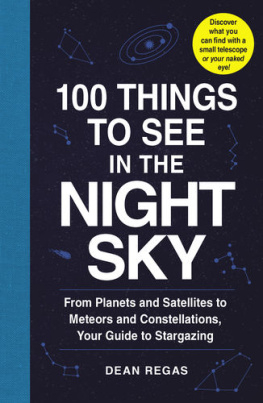CONTENTS
Guide
Thank you for downloading this Simon & Schuster ebook.
Get a FREE ebook when you join our mailing list. Plus, get updates on new releases, deals, recommended reads, and more from Simon & Schuster. Click below to sign up and see terms and conditions.
CLICK HERE TO SIGN UP
Already a subscriber? Provide your email again so we can register this ebook and send you more of what you like to read. You will continue to receive exclusive offers in your inbox.
We hope you enjoyed reading this Simon & Schuster ebook.
Get a FREE ebook when you join our mailing list. Plus, get updates on new releases, deals, recommended reads, and more from Simon & Schuster. Click below to sign up and see terms and conditions.
CLICK HERE TO SIGN UP
Already a subscriber? Provide your email again so we can register this ebook and send you more of what you like to read. You will continue to receive exclusive offers in your inbox.
Introduction
Constellations. Stars. Planets. Nebulas. Satellites.
The universe is full of wonders beyond our imagination. And while much of whats out there in space can only be seen by powerful telescopes or theorized about by professional astronomers, there are many things you can see in the night sky just by walking out your door and looking up.
In 100 Things to See in the Night Sky youll find 100 entries, each telling you about particular objects in the night sky that you can find with either your naked eye, binoculars, or a backyard telescope. Each entry tells you what type of heavenly object you are looking for (planet, star, etc.), how hard it is to find, what the item looks like and its mythology, and where and when to look for it. Youll also find a variety of star maps scattered throughout the entries that will show you exactly where to look when you turn your eyes toward the stars.
The tips, techniques, and informative bits that youll find in the book are the same ones that I used when I first started heading outside every clear night to let the sky become my classroom. Theyre the same tips that turned me into a starstruck astronomer. Hopefully theyll do the same for you, and help you fall in love with the heavens!
But what exactly will you find in this book? Well, first youll learn how to safely observe the Sun, take in sunsets and sunrises, chart the seasons, and observe sunspots. Then youll explore the phases and features of the Moon and uncover the hidden secrets of the five planets closest to Earth: elusive Mercury, dazzling Venus, ruby-red Mars, giant Jupiter, and spectacular Saturn.
Then you will delve into the heart of the book and study the art of stargazing. You will learn how to identify major stars and constellations throughout every season of the year. From beginner star patterns like the Big Dipper and Orions Belt to more challenging constellations like Delphinus, the Dolphin, and Aries, the Ram, you will soon be able to recognize dozens of stars in the night sky and retell their ancient mythological stories.
Finally, youll discover the tricks to observing man-made satellites and supreme heavenly shows such as meteor showers and eclipses.
And, in case youre not sure exactly what you need to do, youll find a chapter packed with information on ideal stargazing locations and sky conditions, what type of equipment you need (in some instances, you just need to use your two eyes and bare hands), the best time to stargaze, and more. So, whether youre looking to learn about the night sky on your own or are looking to get your kids excited about what lies in the skies above, this book is for you. I challenge you to go outside and find every one of the night sky objects detailed here. When you do that, you may be converted to the stars like me, and you may find that youre an astronomer too!
How to Use This Book
The universe is yours to behold and this book can be your beginners guide. It will focus on 100 of the most amazing astronomical objects that you can see in the night sky. Youll find basic information and tips to locate each individual object, often with the help of accompanying charts and graphics. But some general rules and guidelines are necessary to start properly. Lets talk about viewing locations, sections of the sky, various viewing conditions, and any equipment you may have or want to get.
Location, Location, Location
This book is intended mainly for viewing audiences in the mainland United States, southern Canada, northern Mexico, Europe, North Africa, and most of Asia. It is designed to help you view the night sky from the mid-northern latitudes, which means that if youre living or traveling between 25 and 55 degrees north latitude, this is the book for you. Your perspective on the heavens does not change much when you travel east to west, but it does change when you trek north or south. There will be some useful information in this book no matter where you live, but my observing tips and star charts are mainly geared for stargazers living in the mid-northern latitudes.
Break Up the Sky
That said, no matter where you are on Earth, if you stargaze long enough you will notice that the stars, constellations, planets, and the Sun and Moon slowly move across the sky. Hour by hour, minute by minute, they shift as one body. Ancient astronomers pictured the dome of heaven circling around an unmoving Earth. It was as if the gods were manipulating a great wheel behind the scenes that made everything rise and set and circumnavigate the globe once a day.
For beginning stargazers to really experience this motion it helps to break up the sky by the four cardinal directions: north, south, east, and west. When you face north and watch the stars, you will see that they behave quite differently than when you face any other direction. Take some time to sit outside under the stars and note the positions of several bright stars all around you and place them in reference to landmarks like houses, trees, and mountains. If you live in mid-northern latitudes (between 25 and 55 degrees north latitude), on every night of the year this is what you will notice:
North: When you face north, the stars will seem to move in a counterclockwise circle around Polaris, a.k.a. the North Star. You can see star patterns like the Big Dipper and the W-shaped Cassiopeia arcing around the North Star. Many of the stars nearest to the North Star and the constellations in the northern sky never rise or set but endlessly seem to circle. Astronomers call these circumpolar stars.
West: When you face west, the motion seems quite different. Stars, planets, the Moon, and the Sun appear to move diagonally down and to the right until they set below the horizon.
East: When you face east everything rises and travels diagonally up and to the right.
South: When you turn south, the celestial objects move from left to right and almost crawl across the southern horizon.
Knowing how things move in each direction will help you know what stars and constellations are coming next and which objects might be setting soon.
Note: if you are in the Southern Hemisphere, your motions seem different. Objects still rise in the east and set in the west, but they travel up and to the left and down and to the left respectively. Objects in the northern sky move right to left, and the stars in the southern sky completely circle the pole in a clockwise direction. No matter where you live, all of these apparent motions are caused by one thing: the daily rotation of the Earth.










